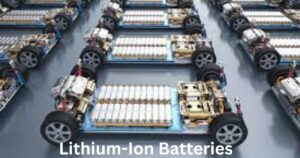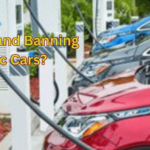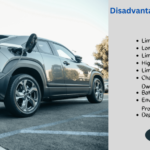Take a closer look at the different types of batteries used in electric vehicles, their advantages, and how they affect the performance of EVs. Dive into the fascinating world of batteries that drive the progress of electric vehicles forward.

Introduction
Electric vehicles (EVs) have revolutionized the automotive industry, offering eco-friendly alternatives to traditional combustion engines. A key component driving this transformation is the battery technology that fuels these vehicles. In this comprehensive guide, we delve into the fascinating realm of different types of batteries used in electric vehicles, exploring their characteristics, advantages, and their impact on the performance of EVs.
Exploring Different Types Of Batteries Used In Electric Vehicles
Lithium-Ion Batteries: Powerhouses of Efficiency and Performance

Lithium-ion batteries, often referred to as Li-ion batteries, stand at the forefront of EV technology. These rechargeable batteries utilize lithium ions to store and discharge energy efficiently. With high energy density and extended lifespan, Li-ion batteries have become the go-to choice for many EV manufacturers. Their ability to provide sustained power over long distances and rapid charging capabilities make them ideal for both short commutes and extended road trips.
Solid-State Batteries: Pioneering the Future of EV Energy Storage

Solid-state batteries represent the next evolution in electric vehicle technology. By replacing traditional liquid electrolytes with solid materials, these batteries offer enhanced safety, faster charging times, and increased energy density. The absence of flammable components reduces the risk of thermal runaway, ensuring a more secure driving experience. As solid-state battery technology continues to advance, EVs equipped with these batteries could revolutionize the industry with even greater performance and range.
Also Read: Expanding EV Charging Infrastructure in Karnataka: A Boost for EV Owners
Nickel-Metal Hydride (NiMH) Batteries: A Reliable and Established Choice

While newer technologies are gaining prominence, nickel-metal hydride batteries still hold their ground as a reliable option for electric vehicles. NiMH batteries are known for their durability, recyclability, and cost-effectiveness. They have been widely used in hybrid vehicles and some earlier EV models. While they may have slightly lower energy density compared to Li-ion batteries, their consistent performance and established infrastructure make them a viable choice for certain applications.
Lithium Iron Phosphate (LiFePO4) Batteries: Balancing Power and Safety

Lithium iron phosphate batteries offer a unique blend of safety, longevity, and performance. These batteries are prized for their thermal stability, making them less prone to overheating and thermal runaway. While they may have a slightly lower energy density compared to traditional Li-ion batteries, their extended lifespan and robustness make them a preferred choice for specific EV models, particularly those prioritizing safety and longevity.
Sodium-Ion Batteries: A Potential Game-Changer

Sodium-ion batteries are emerging as a promising alternative to lithium-based batteries. Sodium is more abundant and cost-effective than lithium, potentially reducing the overall cost of EV production. These batteries also exhibit good energy density and are environmentally friendly. Although sodium-ion battery technology is still in the research and development phase, it holds the potential to reshape the landscape of EV batteries in the future.
Zinc-Air Batteries: Tapping into High Energy Density

Zinc-air batteries leverage the electrochemical reaction between zinc and oxygen to generate power. These batteries boast an impressive energy density and lightweight design, making them attractive for EV applications. However, challenges such as air exposure and limited rechargeability are areas of ongoing research. If these hurdles can be overcome, zinc-air batteries could play a significant role in enhancing the range and efficiency of electric vehicles.
Hydrogen Fuel Cells: Merging Hydrogen and Electricity

Although not strictly batteries, hydrogen fuel cells are worth mentioning in the context of EV power sources. These cells convert hydrogen gas into electricity through an electrochemical process, emitting only water as a byproduct. Hydrogen fuel cells offer quick refueling times and extended range, addressing some of the limitations of traditional battery-powered EVs. However, infrastructure development and production costs remain challenges for widespread adoption.
Capacitors: Unleashing Rapid Energy Release

Capacitors, although not as commonly used as batteries, are gaining attention for their ability to rapidly discharge energy. Ultracapacitors, a type of capacitor, can quickly store and release energy, making them suitable for regenerative braking systems and providing short bursts of power for acceleration. While they may not offer the same energy density as batteries, their efficiency in capturing and releasing energy makes them valuable components in the EV landscape.
Also Read: The Mind-Blowing Future of Electric Vehicles Revealed!
Reusing and Recycling Electric Vehicle Batteries
In recent years, electric-drive vehicles have made their mark on the U.S. auto market, although only a limited number of these vehicles have reached the end of their operational lives. As the prevalence of electric-drive vehicles continues to rise, the potential for battery recycling becomes increasingly significant.
The growing use of battery recycling brings a hopeful prospect of stopping harmful materials from getting into the waste system, both when the batteries are made and when they’re no longer needed. Moreover, recycling efforts can reintroduce critical materials back into the supply chain, enhancing domestic sources for these valuable resources. Currently, extensive research is focused on developing battery-recycling techniques that minimize the life-cycle impacts associated with using various types of batteries, such as lithium-ion batteries, in electric vehicles. However, it’s essential to recognize that not all recycling processes are created equal, and different methods of separation are required for effective material recovery:
Smelting:

Smelting processes are designed to recover basic elements or salts from batteries. These established methods operate at high temperatures and can accommodate a range of battery types, including lithium-ion and nickel-metal hydride batteries. In the smelting process, organic substances such as electrolytes and carbon anodes are utilized as fuel or reductants.This process yields valuable metals that are subsequently sent for refining to make them suitable for various applications. The remaining materials, including lithium, are contained within slag, which is repurposed as an additive in concrete.
Direct Recovery:
On the opposite end of the spectrum, some recycling processes focus on directly recovering battery-grade materials. These methods involve separating battery components through a combination of physical and chemical processes, allowing for the recovery of all active materials and metals. The direct recovery process operates at lower temperatures and consumes minimal energy.
Intermediate Processes:
Situated between the two extremes, intermediate processes offer a balance. These approaches can accommodate different types of batteries, unlike direct recovery methods. Moreover, they recover materials at a point further along the production chain than smelting does.
One of the significant challenges in achieving high-value material recovery lies in the separation of distinct battery materials. Consequently, the design of batteries with disassembly and recycling in mind becomes crucial for the overall sustainability of electric-drive vehicles. Standardizing battery components, materials, and cell designs would further simplify and optimize the recycling process, making it both more efficient and cost-effective. In essence, proactive battery design and comprehensive recycling practices play an indispensable role in ensuring the success and sustainability of electric-drive vehicles in the long run.
Conclusion
The landscape of electric vehicles is continually evolving, driven by advancements in battery technology. From lithium-ion powerhouses to pioneering solid-state innovations, each type of battery brings its unique strengths and capabilities to the table. As research and development continue, the electric vehicle industry holds the promise of even more efficient, powerful, and sustainable batteries that will shape the future of transportation.
FAQs (Frequently Asked Questions)
Are solid-state batteries currently available in commercial electric vehicles?
While solid-state battery technology is still in the experimental phase, some manufacturers are testing prototypes in select EV models. However, widespread commercial availability is yet to be realized.
How do lithium iron phosphate batteries contribute to EV safety?
Lithium iron phosphate batteries have a stable chemical structure that reduces the risk of thermal runaway, making them inherently safer than traditional lithium-ion batteries.
Can I replace my EV’s lithium-ion battery with a sodium-ion battery?
As of now, sodium-ion battery technology is not readily available for consumer vehicles. Retrofitting an EV with a different battery type would require significant modifications and engineering.
What is the main advantage of hydrogen fuel cells over traditional batteries?
Hydrogen fuel cells offer faster refueling times and extended range compared to traditional batteries, addressing some of the limitations of battery-powered EVs.
Are capacitors a feasible replacement for batteries in electric vehicles?
While capacitors excel in rapid energy discharge, they lack the energy density required for long-range EV applications. They are more suitable for specific functions like regenerative braking.
How does the choice of battery impact the overall performance of an electric vehicle?
The choice of battery affects crucial aspects such as range, acceleration, charging speed, and overall lifespan of the electric vehicle.
Also Read: Revolutionizing Urban Transport: 10 Electric Cars Ideal for Indian Cities










4 thoughts on “Different Types Of Batteries Used In Electric Vehicles”